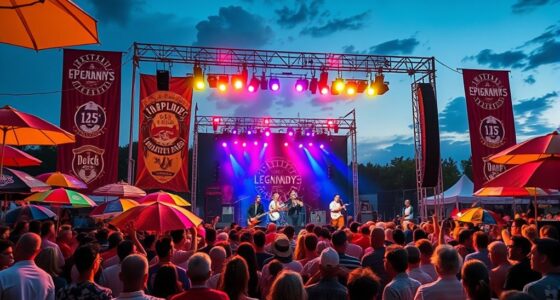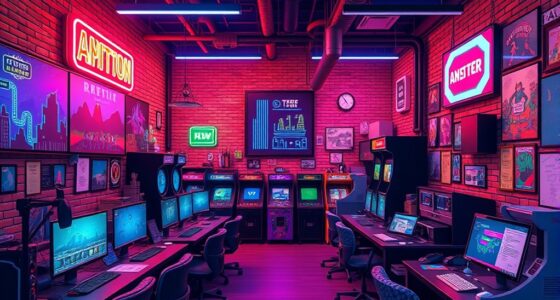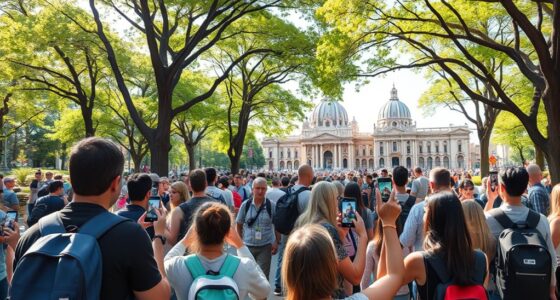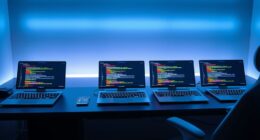When choosing between green screens and LED volumes, consider your budget, timeline, and project needs. Green screens are more affordable upfront, ideal for smaller budgets and quick setups, but require extra post-production work. LED volumes have a high initial cost but offer real-time, high-quality visuals, saving time and ensuring consistency. Understanding these trade-offs helps you find the right balance for your project; explore more details to make an informed decision.
Key Takeaways
- Green screens have lower initial costs and setup complexity, making them suitable for smaller budgets and quick projects.
- LED volumes require a significant upfront investment in hardware and technical setup but offer real-time, high-fidelity backgrounds.
- Post-production costs are generally higher with green screens due to compositing, while LED volumes reduce post-production time and expenses.
- Green screens are more flexible for late-stage changes without reshooting, offering cost savings in project revisions.
- LED volumes are cost-effective for large-scale, high-quality productions needing immersive environments and quick turnaround times.

When choosing between a green screen and an LED volume for your production, understanding their differences can considerably impact your project’s quality and efficiency. One of the key considerations is post-production flexibility. Green screens offer substantial advantages here because they allow you to replace backgrounds digitally after filming. This means you can make changes late in the process without reshooting, giving you more creative control and adaptability. On the other hand, LED volumes provide real-time background rendering, which minimizes the need for extensive post-production work. They enable you to see the final composite live on set, reducing the need for complex editing later. This can be especially beneficial when quick turnaround times are vital, or when you want to guarantee visual consistency during filming. Additionally, visual fidelity with LED volumes is typically higher due to their capacity for detailed, dynamic backgrounds. Setup complexity is another vital factor. Green screens are generally easier and cheaper to set up initially. You need a backdrop, proper lighting, and some post-production finesse, but the physical setup is straightforward. This makes green screens accessible for smaller productions or those with limited budgets. Conversely, LED volumes require a much more elaborate setup. You need high-resolution screens, sophisticated lighting, and specialized hardware to create immersive environments. The setup process is complex and often involves significant technical expertise and higher upfront costs. While LED volumes can deliver stunning visual fidelity in real-time, the initial investment and setup time can be substantial, making them less suitable for quick or low-budget projects. Cost is a major consideration. Green screens tend to be more affordable upfront, especially for smaller crews or independent filmmakers. You can rent or buy a green screen kit and manage post-production costs separately. LED volumes, however, require a hefty initial investment, including the screens, software, and technical staff to operate them. This can be justified for large-scale productions or projects with high visual demands, but it might be overkill for smaller productions with limited budgets. Ultimately, your choice depends on your project’s scope, budget, and timeline. If you prioritize post-production flexibility, lower setup complexity, and cost-efficiency, a green screen might be the better option. But if you need real-time rendering, immersive environments, and can afford the initial setup, an LED volume could elevate your production quality profoundly. Weighing these factors carefully ensures you select the technology that aligns best with your creative goals and logistical constraints.
Frequently Asked Questions
How Long Does Each Setup Typically Take to Install?
The setup time varies depending on your chosen setup. Green screens usually take a few hours to install, as you need to hang the backdrop and set up lighting. LED volume installations tend to be more complex, often taking several days due to the need for rigging, power setup, and calibration. Your installation duration depends on the complexity and scale of your project, so plan accordingly for a smooth process.
Can Both Options Be Used Outdoors Effectively?
Imagine your shoot as a dance—can both partners, green screen and LED volume, truly perform outdoors? While green screens struggle with lighting variability and weather resilience, LED volumes shine brightly outdoors, offering consistent lighting and weather resistance. You can rely on LED volumes outdoors, but green screens need careful planning to handle unpredictable elements. So, choose your partner wisely to keep your performance flawless, rain or shine.
What Are the Common Maintenance Costs for Each?
When considering maintenance costs, you should know that green screens typically require less upkeep but need regular cleaning and fabric replacement due to wear. LED volumes, however, involve higher costs from bulb replacements and system checks. Durability factors like weather resistance impact both options, with LED volumes generally being more durable outdoors. You’ll need to budget for ongoing maintenance to keep your setup functioning smoothly and avoid costly repairs.
How Do Lighting Conditions Affect Each System’S Performance?
You might think lighting conditions don’t impact performance, but they actually play a big role. For green screens, inconsistent lighting can ruin lighting uniformity and cause shadows, making keying difficult. LED volumes, however, adapt better to changing lighting, maintaining uniformity and reducing shadows. Proper lighting ensures both systems perform at their best, but LED volumes generally offer more flexibility in varying conditions, giving you more control over your shot quality.
Are There Specific Projects Better Suited for Green Screens or LED Volumes?
You’ll find green screens ideal for projects needing extensive background flexibility or when you want to easily change scenes in post-production. They require less crew during setup but demand careful lighting to avoid spill. LED volumes excel in live, dynamic scenes, reducing crew requirements for real-time background adjustments. Choose green screens for versatility, especially if post-editing is an option, and opt for LED volumes when real-time interaction and minimal post-work are priorities.
Conclusion
When choosing between green screens and LED volume setups, consider both your budget and production needs. LED volumes can cut post-production time by up to 50%, making them a cost-effective choice for high-quality, real-time visuals. While green screens remain affordable initially, the long-term savings and immersive capabilities of LED volumes often justify the investment. Ultimately, understanding these trade-offs helps you make smarter decisions for your projects’ success.








